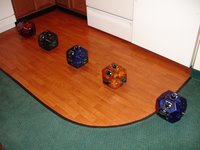 Many of us remember the scene in the first Star Wars film where Luke is being trained in the use of the light saber for the first time. He fights that little floating sphere that shoots lasers at him. Well that image stuck in the minds of some NASA and MIT engineers. And years later they attempted to develop a useful space robot built around the same floating sphere concept. NASA named it the Personal Satellite Assistant, but the floating ball never really got off the ground. But now there is a new take on the PSA concept. It's called SPHERES and it's this weeks robot.
Many of us remember the scene in the first Star Wars film where Luke is being trained in the use of the light saber for the first time. He fights that little floating sphere that shoots lasers at him. Well that image stuck in the minds of some NASA and MIT engineers. And years later they attempted to develop a useful space robot built around the same floating sphere concept. NASA named it the Personal Satellite Assistant, but the floating ball never really got off the ground. But now there is a new take on the PSA concept. It's called SPHERES and it's this weeks robot.SPHERES or Synchronized Position Hold Engage and Reorient Experimental Satellites were developed by the MIT Space Systems Laboratory and Payload Systems for both NASA and DARPA research. The small robot satellites are designed primarily to test autonomous flight and coordination algorithms. The robots are capable of flying in a microgravity environment using small CO2 thrusters positioned all over them. Each robot has smart enough avionics to fly on it's own, yet is built to maintain a steady stream of communication with the other SPHERES and a central computer using a wireless link. The SPHERES navigate through the use of ultrasound scanning and infrared beacons. Each SPHERES is right around 8 inches in diameter and weighs only 7 pounds. Each robot gets it's electrical power form a pair of common household AA batteries.
Only one floating robot has made it's way to the International Space Station for testing thus far. Have a look at the first video of "Red" being booted up for the first time. It isn't doing much just yet, except holding it's position in space. But the real pay off comes when multiple SPHERES start working together. A second robot is being sent up the gravity well to the ISS next month. And the third will follow later this year. Astronauts in space and engineers on the ground have already been putting the first robot through it's paces. Testing it's flight capabilities, communication and navigation skills, and even deliberately causing thruster problems, to see if the robot can fix them. So far Red has passed with flying colors. MIT engineering professor David Miller said, "We've commanded it to do a variety of maneuvers—loops and turns, for instance. And we've tested the robot's ability to solve problems. Not bad for one little droid, I can’t wait to see what three of them can do."
There are plenty of images of more SPHERE tests, both on the ground using tethered or wheeled models, and in the weightless environment of the NASA reduced gravity spacecraft. And also more video of the ground based test vehicles going through some maneuvers. The SPHERES have a great deal of potential to aid in space flight, and NASA has big plans for them. Someday, SPHERES descendants will accompany astronauts on space walks, and provide communication, video, and sensor information both inside and outside of space vehicles. SPHERES may also form the basis for a very large interferometer telescope that is in the works, one that will be composed of a large number of very small satellites working in tandem to give us a much larger "lens" than Hubble ever could. SPHERES could also be used for space based construction projects, and there is speculation that they could even aid in lunar colonization efforts.
Whatever roles future SPHERES are assigned to play, I have no doubt they will participate in coming space exploration. Small autonomous formation flying satellites are smarter, more efficient, and less expensive than their old guard vehicle sized counterparts. SPHERES let you do more with less, which is a doctrine that NASA is going to have to get very cozy with if they want to compete with rising foreign space programs, and more so, privatized space flight. I envision swarms of SPHERES building, repairing, scanning, exploring, and cooperating in and around space far into the future. These little guys are just getting started, and for them the sky is clearly not the limit. [via NASA]
“There is geometry in the humming of the strings, there is music in the spacing of the spheres.” - Pythagorus
No comments:
Post a Comment